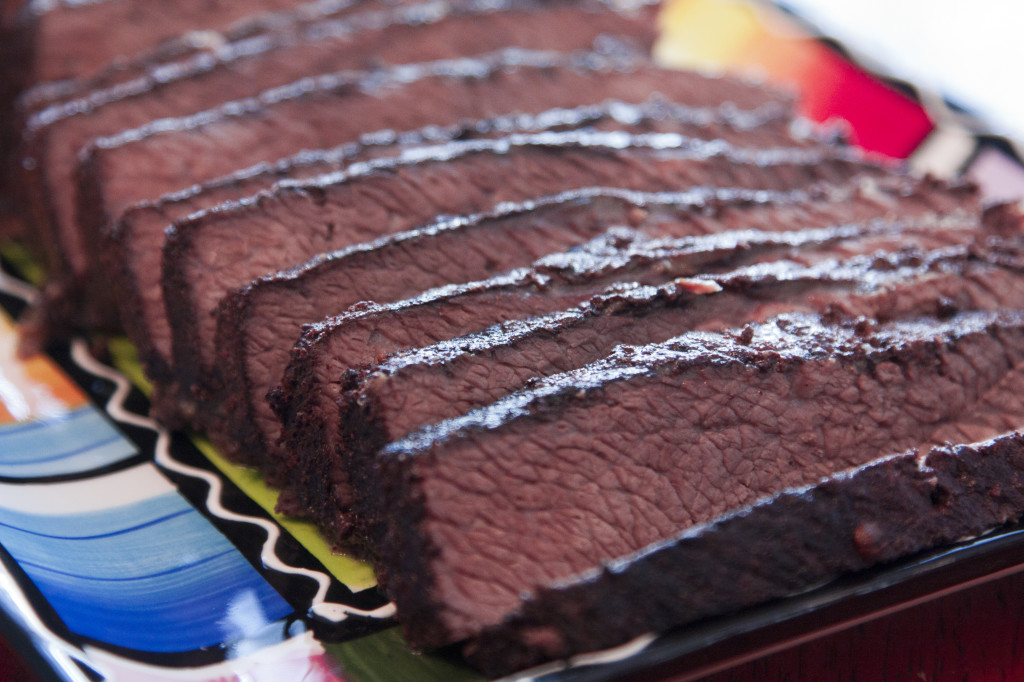 Although the Irish in me absolutely loves my beef brisket as corned beef and cabbage; slow cooked to perfection and tenderly falling apart—this year I wanted something just, well, different. I wanted adventure. Not only that, but when I wrote this I was busy building and remodelling my old office in mid-town Anchorage (yes, I wield quite the hammer 😉 And not only that, our record-setting Anchorage snowfall beckoned from the ski slopes.
Although the Irish in me absolutely loves my beef brisket as corned beef and cabbage; slow cooked to perfection and tenderly falling apart—this year I wanted something just, well, different. I wanted adventure. Not only that, but when I wrote this I was busy building and remodelling my old office in mid-town Anchorage (yes, I wield quite the hammer 😉 And not only that, our record-setting Anchorage snowfall beckoned from the ski slopes.
I did it—and bring you an adventurous rub with convenience. But first a few words:
Selecting your meat:
Meat grade. Beef is graded based on the age of the animal and the amount of fat marbling. The most common grades, from lowest to highest are: Select, choice, prime, and Wagyu. As long as your meat is grass fed and raised without hormones or antibiotics, marbling makes the meat more tender, flavorful, and juicy. Prime and Wagyu are definitely the way to go with this cut.
Two of my favorite vendors: In Anchorage you can select the cut you like by visiting Duane Clark at Sears Mall 10-4 on Thursdays. I’ve seen the Clark family farm and met his animals. Beautiful. When buying a brisket in person, pick it up to see whether it bends if held on one end. If it doesn’t, find another one as it will be too tough. If buying in person doesn’t work you can buy a quality brisket here.
What about grass fed beef? Unfortunately, if your meat is not grass fed and humanely raised, it is loaded with all manner of hormones to make the animal get to size faster plus those animals need antibiotics because they are more likely than grass-fed to get sick. As well, the grain-based feed used often contains toxic chemicals—some that are even banned from production like PCBs. In fact, you might be disgusted by some of the things fed to commercial dairy and beef cows. Out of respect for you coming here to find a delicious recipe I won’t list them, but if you are interested read this Union of Concerned Scientists article.
Grains fatten the animals more quickly, but they don’t result in healthy fats in those animals. Grass-fed meat is low in “bad” fat (including saturated fat). It gives you from two to six times more of a type of “good” fat called “omega-3 fatty acids.”
We’ve heard how omega-3 fatty acids are essential for health. People deficient in omega-3 fatty acids tend to experience more anxiety, hyperactivity and depression, they are more likely to get Alzheimers, they tend to have irregular heartbeats and are more likely to have serious cardiac events and even high blood pressure.
Grass-fed, but not grain-fed, meat is an excellent source of omega-3s because these fats are formed in the green leaves (specifically the chloroplasts) of plants. Sixty percent of the fat content of grass is a type of omega-3 fatty acid called alpha-linolenic or LNA. Even those cattle that are “finished on grain” lose their valuable store of LNA as well as two other types of omega-3 fatty acids, EPA and DHA very rapidly when sent to the feedlot.
With Brisket, this is very important because the fat surface on the outside of the meat will baste and tenderize as you slow cook the meat. In other words, you want the fat.
I cannot stress this enough: When shopping for brisket, go grass-fed and go for the highest grade you can find. Brisket is the classic example of “garbage in garbage out”. If the grade is not labeled, chances are it is “select.” Avoid it. Please don’t write to me and say you can’t figure out why your brisket was tough if you did not buy USDA Choice or better. Also hand pick the piece with the most fat striation visible–which is why pastured, grass-fed, and free of all those additives is important.
Yield. Calculate about 1 pound of meat or more per person. There will be significant loss, up to 20% from fat trimming and up to 40% from shrinkage. You’ll end up with about half a pound per person, more than enough and maybe you’ll have some leftovers. Figure 12 servings if you are cooking a whole packer of about 12 pounds. Usually, your store or butcher sells smaller cuts.
Ingredients:
1 Tablespoons ground or whole white peppercorns
1 Tablespoons ground or whole coriander
4½ Tablespoons ground cinnamon
2 teaspoons ground nutmeg
1 teaspoons ground cloves
3½ Tablespoons unsweetened cocoa or cacao powder
2-4 Tablespoons fine ground sea salt
2-4 Tablespoons extra virgin olive oil
3 pound Grass fed brisket
Preparation:
Preparation time. 15 minutes to make and apply the rub. If you can, let the rub soak in for an hour or two, or even overnight.
Cooking time. Rule of thumb: 50 minutes per pound at 190°F.
- If using whole pepper and coriander, in a sauce pan, sauté the peppercorns and coriander until they just start to pop.
- Immediately remove from the heat and put in your spice mill or Magic Bullet; grind thoroughly. (In a pinch you can mash them with the back of a spoon against a glass bowel, but this takes a little longer…)
- Mix in all the other spices.
- You can trim the fat off your brisket now, or later, your choice. It is easier to trim after it’s cooked. That said, some of the rub is lost if you wait. I trim it down to ¼ inch before cooking—use a very sharp knife.
- Rub the brisket in olive oil and then rub the spice mixture all over. Let sit several hours or overnight.
- OVEN METHOD: Place the brisket fat side down in an oven dish. Seal the dish with foil. And I do mean seal—you do not want moisture escaping of the brisket could dry out.
- Put in your oven then set your oven to 190-200°F depending on how low it can go. Allow 50 minutes per pound. Go do something else…
…Some time later come back and take your brisket out of the oven. Let it rest while you finish up some of the sides you’ll serve. - SMOKER METHOD: Basically the same as long as you can set the temperature on your smoker. Halfway through the time, flip the brisket. Brisket cuts can be tough. Smoking them helps.
Slice: don’t slice until the absolute last possible minute or it can dry out. When you do slice it, use a very sharp knife, cut across the grain, and slice as thinly as possible.
mmmm…. Serve immediately
Copyright © 2012-20 Marie Cecchini Sternquist. All Rights Reserved








If you desire to improve your family’s health just keep visiting this web site
and be updated with the newest news update posted here.
There’s definately a great deal to learn about this health topic.
I like all the points you made.
Hi there, I log on to your new stuff daily. Your writing style
is awesome, keep iit up!
Thank you! I’m glad you enjoy my healthy views and recipes. Cheers!
Hi, I’ve been a lurker around your blog for a few months. I love this article and your entire site! Looking forward to reading more!
Pingback: The adventure of chocolate and grass-fed beef … | Our Nutrition Kitchen